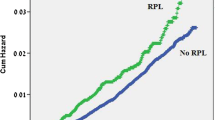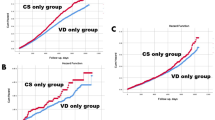Abstract
Purpose
To investigate whether an association exists between preterm delivery and a future risk for female malignancies.
Methods
A population-based study compared the incidence of long-term female malignancies in a cohort of women with and without a history of PTD. Deliveries occurred between the years 1988–2013, with a mean follow-up duration of 12 years. We excluded women with known genetic predisposition or malignancies prior to the index pregnancy. Malignancies investigated included ovarian, uterine, breast and cervix. Cumulative incidence was assessed using a Kaplan–Meier survival curve. A Cox proportional hazards model was used to estimate the adjusted hazard ratios (HR) for female malignancy.
Results
During the study period, 105,033 women met the inclusion criteria; 16.8 % (n = 17,596) of the patients delivered preterm. Patients with a history of PTD did not have an increased risk of later being diagnosed with female malignancies. The results remained insignificant in a sub-analysis based on malignancy type, early PTD, induced vs. spontaneous, and number of episodes per patient. Kaplan–Meier cumulative incidence was similar between the groups, and the adjusted HR was not significant (1.04, 95 % CI 0.88–1.22; p = 0.665).
Conclusion
A history of PTD does not appear to elevate the risk for subsequent long-term female malignancies.


Similar content being viewed by others
References
Bonamy AK, Parikh NI, Cnattingius S, Ludvigsson JF, Ingelsson E (2011) Birth characteristics and subsequent risks of maternal cardiovascular disease: effects of gestational age and fetal growth. Circulation 124:2839–2846
Kessous R, Shoham-Vardi I, Pariente G, Sergienko R, Sheiner E (2015) Long-term maternal atherosclerotic morbidity in women with pre-eclampsia. Heart 101:442–446
Kessous R, Shoham-Vardi I, Pariente G, Sergienko R, Sheiner E (2014) Intensified risk for long term maternal cardiovascular morbidity in patients with recurrent and severe preeclampsia. Am J Obstet Gynecol 210(1):S162–S163
McDonald SD, Han Z, Walsh MW, Gerstein HC, Devereaux PJ (2010) Kidney disease after preeclampsia: a systematic review and meta-analysis. Am J Kidney Dis 55:1026–1039
Gotsch F, Romero R, Erez O et al (2009) The preterm parturition syndrome and its implications for understanding the biology, risk assessment, diagnosis, treatment and prevention of preterm birth. J Matern Fetal Neonatal Med 22(Suppl 2):5–23
Goldenberg RL, Culhane JF, Iams JD, Romero R (2008) Epidemiology and causes of preterm birth. Lancet 371:75–84
Catov JM, Newman AB, Roberts JM et al (2007) Preterm delivery and later maternal cardiovascular disease risk. Epidemiology 18:733–739
Hoyme UB (2016) Pragmatic prevention of preterm birth and evidence based medicine. Arch Gynecol Obstet 294(1):1–3
Sabour S (2015) Prediction of preterm delivery using levels of VEGF and leptin in amniotic fluid from the second trimester: prediction rules. Arch Gynecol Obstet 291(4):719
Xu P, Alfaidy N, Challis JR (2002) Expression of matrix metalloproteinase (MMP)-2 and MMP-9 in human placenta and fetal membranes in relation to preterm and term labor. J Clin Endocrinol Metab 87:1353–1361
Kim A, Lee ES, Shin JC, Kim HY (2013) Identification of biomarkers for preterm delivery in mid-trimester amniotic fluid. Placenta 34:873–878
Seong WJ (2016) Amniotic fluid CA-125 as a marker of intra-amniotic inflammation associated with preterm delivery: a preliminary single center study. Arch Gynecol Obstet 293(1):55–59
Schüler S, Ponnath M, Engel J, Ortmann O (2013) Ovarian epithelial tumors and reproductive factors: a systematic review. Arch Gynecol Obstet 287(6):1187–1204
Althuis MD, Fergenbaum JH, Garcia-Closas M, Brinton LA, Madigan MP, Sherman ME (2004) Etiology of hormone receptor-defined breast cancer: a systematic review of the literature. Cancer Epidemiol Biomark Prev 13:1558–1568
Fishman J, Osborne MP, Telang NT (1995) The role of estrogen in mammary carcinogenesis. Ann N Y Acad Sci 768:91–100
Britton JA, Gammon MD, Schoenberg JB et al (2002) Risk of breast cancer classified by joint estrogen receptor and progesterone receptor status among women 20–44 years of age. Am J Epidemiol 156:507–516
Zhang ST, Zuo C, Li WN, Fu XQ, Xing S, Zhang XP (2016) Identification of key genes associated with the effect of estrogen on ovarian cancer using microarray analysis. Arch Gynecol Obstet 293(2):421–427
Guo S, Russo IH, Lareef MH, Russo J (2004) Effect of human chorionic gonadotropin in the gene expression profile of MCF-7 cells. Int J Oncol 24:399–407
Koochekpour S, Bullock P, Dean A, Pilkington G, Merzak A (1995) Expression of vascular endothelial growth-factor in the cyst fluid of human cerebral gliomas. Oncol Rep 2:1147–1149
Cohen T, Nahari D, Cerem LW, Neufeld G, Levi BZ (1996) Interleukin 6 induces the expression of vascular endothelial growth factor. J Biol Chem 271:736–741
Nelson AR, Fingleton B, Rothenberg ML, Matrisian LM (2000) Matrix metalloproteinases: biologic activity and clinical implications. J Clin Oncol 18:1135–1149
Roomi MW, Kalinovsky T, Rath M, Niedzwiecki A (2012) Modulation of u-PA, MMPs and their inhibitors by a novel nutrient mixture in human female cancer cell lines. Oncol Rep 28:768–776
Melbye M, Wohlfahrt J, Andersen AM, Westergaard T, Andersen PK (1999) Preterm delivery and risk of breast cancer. Br J Cancer 80:609–613
Statistics TCBo. Israel in figures 2013. http://www.cbs.gov.il/www/publications/isr_in_n13e.pdf. Accessed 25 May 2015
Dossus L, Allen N, Kaaks R et al (2010) Reproductive risk factors and endometrial cancer: the European Prospective Investigation into Cancer and Nutrition. Int J Cancer 127:442–451
Fortner RT, Ose J, Merritt MA et al (2015) Reproductive and hormone-related risk factors for epithelial ovarian cancer by histologic pathways, invasiveness and histologic subtypes: results from the EPIC cohort. Int J Cancer 137(5):1196–1208
Kobayashi S, Sugiura H, Ando Y et al (2012) Reproductive history and breast cancer risk. Breast Cancer 19:302–308
Grisaru-Granovsky S, Gordon ES, Haklai Z, Schimmel MS, Drukker L, Samueloff A, Keinan-Boker L (2015) Delivery of a very low birth weight infant and increased maternal risk of cancer and death: a population study with 16 years of follow-up. Cancer Causes Control 26:1593–1601
Author information
Authors and Affiliations
Corresponding author
Ethics declarations
Conflict of interest
All authors declare that no authors (nor their institutions) received payments for their efforts on this project. The authors report no conflict of interest.
Ethics approval
The study was approved by the institutional review board of Soroka University Medical Center. For this type of study—population-based cohort study—formal consent is not required.
Funding
This study was not funded.
Electronic supplementary material
Below is the link to the electronic supplementary material.
Rights and permissions
About this article
Cite this article
Kessous, R., Walfisch, A., Meirovitz, M. et al. Preterm delivery and future maternal risk of female malignancies. Arch Gynecol Obstet 295, 205–210 (2017). https://doi.org/10.1007/s00404-016-4198-3
Received:
Accepted:
Published:
Issue Date:
DOI: https://doi.org/10.1007/s00404-016-4198-3




